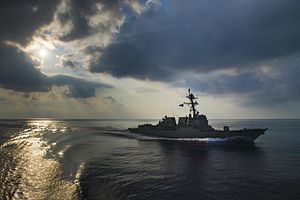On Sunday, a U.S. Navy warship conducted a freedom of navigation operation near a feature claimed by China, the Philippines, and Taiwan. USS Preble, an Arleigh Burke-class guided missile destroyer, sailed within 12 nautical miles of Scarborough Shoal.
The operation marked the second reported freedom of navigation operation by the U.S. Navy in the South China Sea in the month of May. The Trump administration has typically conducted these operations with an average gap of two months between each one.
Earlier this month, USS Preble and USS Chung Hoon, another Arleigh Burke-class destroyer, sailed within 12 nautical miles of Gaven and Johnson Reefs in the Spratly Islands. Each is the site of an artificial island constructed by China since 2014. Scarborough Shoal does not contain an artificial island and has not been subject to land reclamation activities.
Sunday’s transit was designed to “challenge excessive maritime claims and preserve access to the waterways as governed by international law,” according to U.S. Navy 7th Fleet spokesman Lt. Joe Keiley.
The operation also followed U.S.-Philippine joint maritime activities near Scarborough Shoal. The shoal was the site of a major standoff in 2012 between China and the Philippines. Since then, Beijing has exercised de facto control of the waters around Scarborough Shoal.
It was China’s seizure of Scarborough Shoal that prompted Manila to file a case with a Hague-based tribunal in 2013. In 2016, the tribunal issued an award that largely decided in favor of Manila. China was not a participant in the arbitration process and has largely ignored the outcome.
The U.S. Navy has emphasized that its freedom of navigation program does not specifically target China. “All operations are designed in accordance with international law and demonstrate that the United States will fly, sail and operate wherever international law allows,” Keiley said, adding that “FONOPs are not about any one country, nor are they about making political statements.”
The U.S. Navy’s freedom of navigation program is designed to underscore excessive maritime claims by any country. U.S. FONOPs have been conducted all over the world challenging excessive claims by allies, partners, and adversaries alike.
Over the last year, the Trump administration has drawn attention to China’s continued militarization of the South China Sea, particularly in the Spratly Islands.
The U.S. Department of Defense released an annual public assessment of Chinese military power earlier this month. That report observed that Beijing’s artificial islands in the Spratly Islands were subject to considerable militarization throughout 2018.
Beijing placed “anti-ship cruise missiles and long-range surface-to-air missiles on outposts in the Spratly Islands, violating a 2015 pledge by Chinese President Xi Jinping that ‘China does not intend to pursue militarization’ of the Spratly Islands,” the report said.
The report added that “No substantial land has been reclaimed at any of the outposts since China completed its artificial island creation in the Spratly Islands in late 2015, after adding over 3,200 acres of land to the seven features it occupies in the Spratlys.”

































